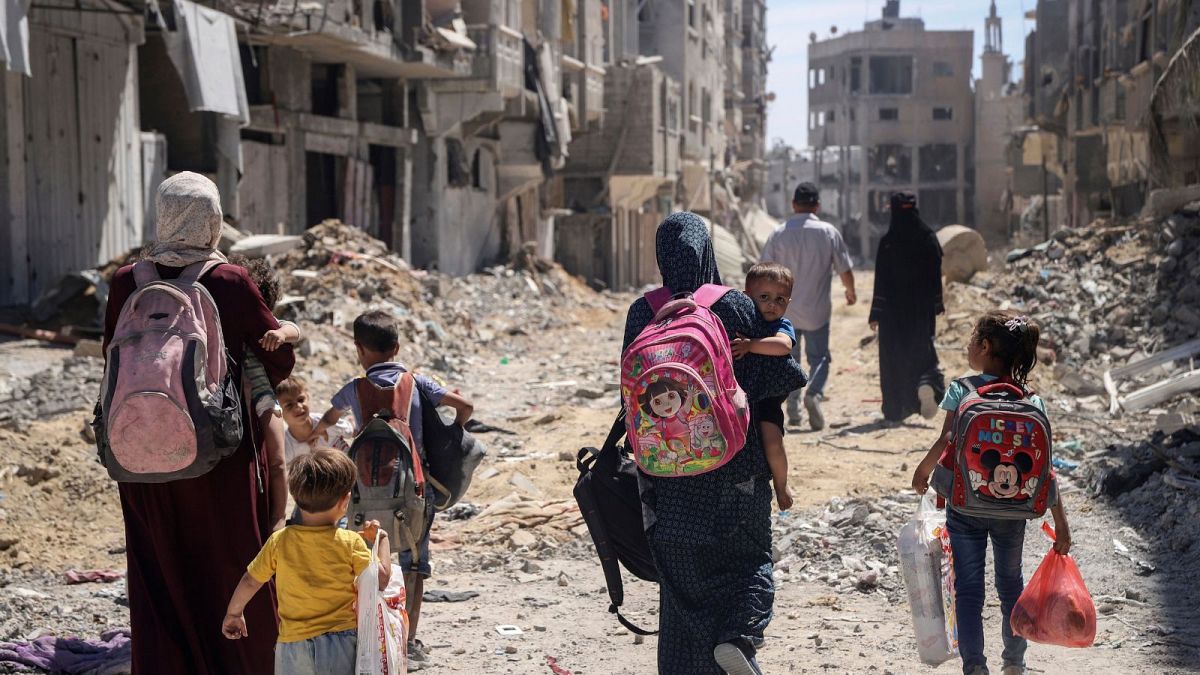“It’s like a slow death”: Environmental impacts of Gaza war revealed in first UN report

The new UNEP assessment followed a request from the Palestinian state to take stock of the environmental damage.
Families are forced to burn plastic to cook food, raw sewage flows onto the beaches and there are over 107 kilograms of garbage per square meter.
The UN Environment Programme (UNEP)’s first assessment of the war in Gaza details the “unprecedented” environmental impact of Israeli attacks over the past eight months.
The preliminary assessment published yesterday is a response to a official request from the State of Palestine in December last year.
“Not only are the people of Gaza facing untold suffering due to the ongoing war, but the significant and increasing environmental damage in Gaza threatens to force the population into a painful and lengthy reconstruction process,” said Inger Andersen, Executive Director of UNEP.
More than 37,000 people have been killed in the Gaza Strip after Hamas-led militants killed around 1,200 Israelis and took 250 people hostage on October 7, according to the Health Ministry.
“We urgently need a ceasefire to save lives and restore the environment so that Palestinians can recover from the conflict and rebuild their lives and livelihoods in Gaza,” says Andersen.
What did the UN environmental impact assessment for Gaza reveal?
Because it is not safe for UNEP to work on the ground, the report relies on remote sensing surveys and data from Palestinian and multilateral partners.
“Although many questions remain about the exact nature and amount of pollutants entering the environment in GazaPeople are already living with the consequences of conflict-related damage to environmental management systems and pollution,” adds Andersen.
“Water and sanitation services have collapsed. Critical infrastructure remains destroyed. Coastal areas, soils and ecosystems are severely affected. All of this is deeply damaging people’s health, food security and Gaza’s resilience.”
Here are seven key takeaways from the preliminary assessment.
7. The conflict is undoing recent environmental progress in Gaza
Gaza’s ecosystems have been under pressure for decades due to recurring conflicts, rapid urbanisation, the political situation and the region’s vulnerability to climate change.
However, there had been some limited progress in environmental management systems. Water desalination and sewage treatment plants had been developed, solar energy was on the rise, and Wadi Gaza coastal wetland benefited from new investment flows.
The war destroyed all of that.
6. Around 39 million tons of rubble have accumulated
According to UNEP estimates, there are now over 107 kg of rubble per square meter in the Gaza Strip. That is more than five times the amount of rubble from the 2016-2017 conflict in Mosul, Iraq.
debris endangers human health and the environment – through dust and contamination with unexploded ordnance, asbestos, industrial and medical waste and other hazardous substances.
The human remains buried under the rubble must be handled with sensitivity, demands the UNEP.
Clearing the rubble will be a huge and complex task, it said, and the task must begin as soon as possible so that other recovery and reconstruction work can proceed.
5. All five sewage treatment plants in the Gaza Strip have been closed
Water, sanitation and hygiene systems in the enclave are almost completely destroyed. sewage pollutes beaches, coastal waters, soil and freshwater with a variety of pathogens, nutrients, Microplasticsand dangerous chemicals.
UNEP warns that this poses immediate and long-term threats to the health of the Gaza population, marine life and agricultural land.
4. The waste management system is severely damaged
According to the report, five out of six waste disposal facilities in the Gaza Strip have been damaged.
By November 2023, 1,200 tonnes Garbage Every day people gathered around camps and emergency shelters.
“We have never lived next to garbage,” Asmahan al-Masri, a displaced woman from Khan Younis, told the BBC. “I cry like any other grandmother when her grandchildren are sick and have scabies. It’s like a slow death. There is no dignity.”
The lack of cooking gas forces families to burn wood, plastic and garbage instead, which particularly endangers women and children.
This, together with fires and fuel burning, has likely led to a significant deterioration in air quality in the Gaza Strip, although no publicly available data on air quality in the Gaza Strip is available.
3. Ammunition containing heavy metals and explosive chemicals remains
These chemical weapons have been used in densely populated areas of the Gaza Strip, contaminating soil and water sources and posing a threat to human health that will persist long after the war ends.
The report warns that unexploded ordnance poses a particularly great danger to children.
2. Destroyed solar modules leave toxic traces
Solar energy is crucial for Gaza residents as it allows them to circumvent Israel’s control of the centralized electricity sector. Gaza has perhaps the highest density of Solar system on the roof systems in the world, according to experts from the Center for Strategic and International Studies.
Much of this infrastructure has been destroyed by Israel’s ongoing bombings – and this could lead to a larger environmental problem.
UNEP warns that destroyed solar panels could leak lead and other heavy metals, posing a new threat to soil and water in the Gaza Strip.
1. Hamas’ tunnels could become dangerous ruins
Hamas’ tunnel system and Israel’s efforts to destroy it could cause further environmental damage, according to UNEP.
Depending on the construction standards of the tunnels and the extent to which water is pumped into them, the report warns of long-term risks to human health from groundwater contamination and to buildings constructed on potentially unstable ground surfaces.
Can the environment in Gaza recover?
Addressing the environmental problems in the Gaza Strip is crucial for the health of the population and must be included in reconstruction plans, the authors say.
They say a complete environmental analysis – taking into account contamination by weapons and other conflict-related pollution – must be an integral part of these plans.
Reconstruction of the Gaza Strip should also address chronic environmental problems that existed before the war, UNEP adds.
Once safety conditions permit and access is granted, the UN agency plans to begin an on-site assessment of the extent and nature of the environmental degradation, building on this preliminary assessment.
Solutions will be developed together with the Gaza Strip’s scientific community, experts from the public and private sectors, and civil society, including women and youth.



